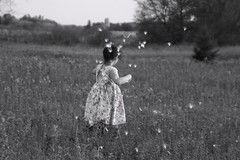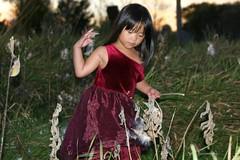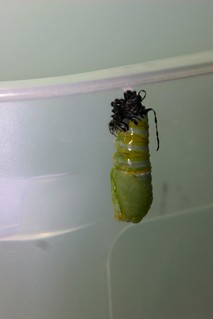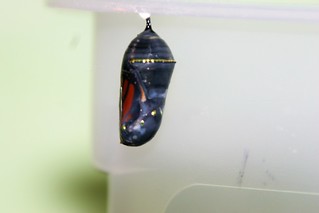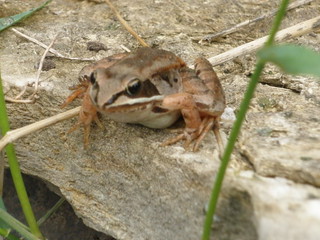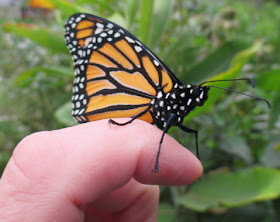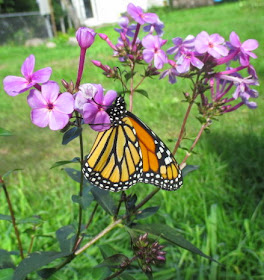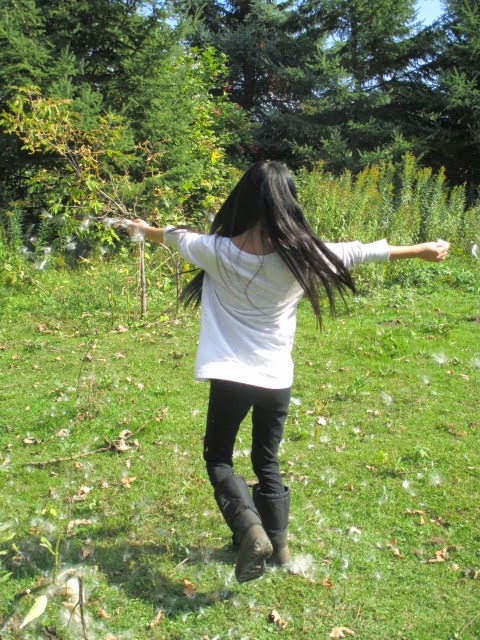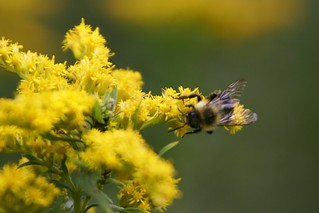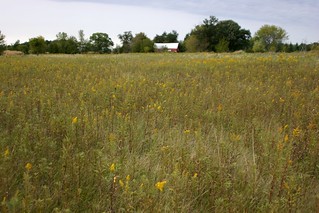I've been wanting to make this recipe for some time after seeing the pin on Pinterest for it. The pin led to The Garden Grazer which featured this vegan, gluten-free recipe back in May.
Although the recipe says that it makes enough for about 8 tacos, we found that we were able to make many more than 8 tacos and/or nachos from the filling and sauce. This was an easy recipe to make and very tasty! It is one that we will definitely be enjoying again.
To make Black Bean Tacos with Avocado Cilantro Sauce, you'll need:
2 (15 oz.) cans black beans
1 c. salsa (purchased or homemade)
1 tsp. cumin
Corn tortillas
Toppings of your choice: lettuce, tomato, onion, roasted red peppers, corn, avocado, cilantro, etc.
For the sauce, you'll need:
1/2 ripe avocado
3/4 cup cilantro, stems removed
Juice from 1 lime
1 clove garlic
1 tbsp. olive oil
1 tsp. agave/honey
1/8 tsp. salt
To make the tacos, start with the avocado sauce: In a food processor or blender, add all sauce ingredients and blend. Add some water to thin (if necessary) and modify seasonings to taste. Set the sauce aside, or refrigerate if making ahead of time.
Now for the filling: In a pan over medium heat, add black beans (rinsed and drained), salsa, and cumin. Heat for about 5 minutes stirring occasionally, until heated through. (Optional: mash beans after heating for a creamier filling. I didn't do this.)
While the beans are heating, chop and prepare your toppings. Warm the tortillas if desired.
To assemble the tacos: Spoon the black bean mixture in the center of the tortillas, drizzle a small amount of avocado sauce over the top, and add the toppings.
Tuesday, September 30, 2014
Sunday, September 28, 2014
Strawberry Watermelon Mint Infused Water
Earlier this month I made Strawberry Watermelon Mint Infused Water. The idea came from a pin on Pinterest that led to Positive Med.
The recipe is simple - it only needs five items:
10 large strawberries
½ cup of sliced watermelon
¼ cup of mint leaves
6 cups of water
Ice
The directions for making the infused water are even easier:
Fill the bottom of a pitcher with the ice cubes and top it with strawberries, watermelon and mint leaves. Fill the rest of the way with filtered water and let it cool.
Apparently the idea for the recipe came from a recipe on Recipes Remembered for Strawberry Mint Infused Water.
Basically you start with four ingredients:
8-10 large strawberries
1/4 cup mint leaves
2 cups ice
6 cups filtered water
To make the Strawberry Mint Infused Water, simply clean and hull the strawberries, and cut into halves or quarters (depending on personal preference and the size of the strawberries).
Fill the bottom of a pitcher with the ice cubes. Top with strawberries and mint leaves. Fill the rest of the way with the filtered water.
Place the pitcher in the refrigerator for at least an hour for the flavors to infuse.
Note: as you drink the infused water, you keep adding more filtered water. The ice water makes the fruit last for a few days. Beyond that, the fruit gets rather soggy and is not pleasantly edible. This is particularly true with the watermelon which tasted water-logged and flavorless. The water, on the other hand, was nicely flavored.
The recipe is simple - it only needs five items:
10 large strawberries
½ cup of sliced watermelon
¼ cup of mint leaves
6 cups of water
Ice
The directions for making the infused water are even easier:
Fill the bottom of a pitcher with the ice cubes and top it with strawberries, watermelon and mint leaves. Fill the rest of the way with filtered water and let it cool.
Apparently the idea for the recipe came from a recipe on Recipes Remembered for Strawberry Mint Infused Water.
Basically you start with four ingredients:
8-10 large strawberries
1/4 cup mint leaves
2 cups ice
6 cups filtered water
To make the Strawberry Mint Infused Water, simply clean and hull the strawberries, and cut into halves or quarters (depending on personal preference and the size of the strawberries).
Fill the bottom of a pitcher with the ice cubes. Top with strawberries and mint leaves. Fill the rest of the way with the filtered water.
Place the pitcher in the refrigerator for at least an hour for the flavors to infuse.
Note: as you drink the infused water, you keep adding more filtered water. The ice water makes the fruit last for a few days. Beyond that, the fruit gets rather soggy and is not pleasantly edible. This is particularly true with the watermelon which tasted water-logged and flavorless. The water, on the other hand, was nicely flavored.
Timothy of the Cay - Read 52 Books in 52 Weeks - Week 40
When I was in sixth grade I remember reading The Cay by Theodore Taylor. The book captivated me at the time and it was one that stood out from all the books I read.
The Cay is a short, but powerful, book. It was written in 1969, and dedicated to Dr. Martin Luther King, Jr. It shows the reality of racism and how - especially prior to and in the early part of the 20th century - not all people were treated with respect and valued for who they were.
In that book, a youth's blindness (due to an accident after the boat he was on was torpedoed) symbolically represented how Taylor would like us to see all people. It was Taylor’s intention to show through Timothy (the older African-American gentleman) that the value of a person is not found in the color of their skin, but who they are as a human being. Eventually Philip (the youth) does overcome the prejudice his mother had instilled in him.
So, for the 40th week of the Read 52 Books in 52 Weeks challenge, I was interested in reading Timothy of the Cay which is a prequel-sequel to The Cay. The 27-chapter book alternates (for the most part) between Timothy's life prior to arriving on The Cay and Philip's life after being rescued from The Cay. The theme of this story is making dreams a reality.
Timothy's life revolved around his life in "Back O' All," the poorest section of the squatter's village Charlotte Amalie, on the U.S. Virgin Island of St. Thomas. He was abandoned as a baby and raised by Hannah Gumbs, a former coal carrier turned washer-woman.
As a boy, he dreamed of being a captain of his own schooner, which he meant to name after the woman he called "Tante Hannah." Even though she was not Timothy's biological aunt, Timothy still referred to her as this.
Hanna Gumbs died during Timothy's first four years at sea.Timothy worked long and hard enough to be able to afford a schooner. He gained much knowledge of the sea to be able, in his last months, to help Phillip Enright, Jr. survive on a cay in El Boca de Diablo, "the Devil's Mouth."
After the captain of the Hettie Redd died, Timothy was asked to bring his body back for burial. As the temporary captain of the ship, he reluctantly agreed, suspecting that a violent storm might strike. One did, and sank the Hettie Redd all all its crew and passengers - except him. He felt guilty for the rest of his life, and often wished he too had drowned in the storm.
When he was 70 years of age, Timothy signed aboard the S.S. Hato, the Dutch-registered freighter that, according to The Cay, was sunk in April 1942, as an A.B., an able-bodied seaman, in response to a call for volunteers placed early in 1942.
When the S.S. Hato picked up Phillip Enright and his mother in Curaçao, of what were then the Netherlands Antilles, they were fleeing to their native Virginia. Instead the S.S. Hato was torpedoed. As it sank, Phillip was struck on the back of the head by a piece of loose timber just as he was being thrown aboard a raft, which blinded him two days later.
In Timothy of the Cay, the focus of Philip's story centers on life after being rescued from The Cay in El Boca de Diablo. Phillip was reunited with his parents and they explored the possibility of having a high-risk surgery to restore his vision.
His mother was very concerned about the surgery since there was a risk of death, paralysis, and/or no change in vision. The success rate had been mixed. Philip's father, however, felt that Philip should be given the opportunity to make his own decision about whether to undergo the surgery. He had, after all, survived on the island both with Timothy and then on his own.
Philip decided to move forward with the surgery, and the operation was a success, restoring most of Phillip's vision, though he would need glasses from that day forward.
He and his father made plans to visit The Cay where he and Timothy had survived for just over three months, until Timothy had been killed in a hurricane that had struck The Cay when flying debris had severely lacerated him. Timothy had given his life to protect Phillip's, using his body to shield Phillip from the debris. Phillip had survived alone for almost two months afterwards, thanks to Timothy's having prepared him for just that.
The end of the book focuses on the voyage that Philip and his father took to The Cay. It looked at the closure Philip needed after the experience as well as to see the place that he and Timothy shared. In that trip, he realized how wise Timothy was - far beyond what he had even known when Timothy was alive.
Although I preferred The Cay to Timothy of the Cay, the latter book was worthwhile to read to better understand who Timothy was and what happened to Philip after being rescued. It would be interesting to go back now and read The Cay over again with this information and background in mind.
The Cay is a short, but powerful, book. It was written in 1969, and dedicated to Dr. Martin Luther King, Jr. It shows the reality of racism and how - especially prior to and in the early part of the 20th century - not all people were treated with respect and valued for who they were.
In that book, a youth's blindness (due to an accident after the boat he was on was torpedoed) symbolically represented how Taylor would like us to see all people. It was Taylor’s intention to show through Timothy (the older African-American gentleman) that the value of a person is not found in the color of their skin, but who they are as a human being. Eventually Philip (the youth) does overcome the prejudice his mother had instilled in him.
So, for the 40th week of the Read 52 Books in 52 Weeks challenge, I was interested in reading Timothy of the Cay which is a prequel-sequel to The Cay. The 27-chapter book alternates (for the most part) between Timothy's life prior to arriving on The Cay and Philip's life after being rescued from The Cay. The theme of this story is making dreams a reality.
Timothy's life revolved around his life in "Back O' All," the poorest section of the squatter's village Charlotte Amalie, on the U.S. Virgin Island of St. Thomas. He was abandoned as a baby and raised by Hannah Gumbs, a former coal carrier turned washer-woman.
As a boy, he dreamed of being a captain of his own schooner, which he meant to name after the woman he called "Tante Hannah." Even though she was not Timothy's biological aunt, Timothy still referred to her as this.
Hanna Gumbs died during Timothy's first four years at sea.Timothy worked long and hard enough to be able to afford a schooner. He gained much knowledge of the sea to be able, in his last months, to help Phillip Enright, Jr. survive on a cay in El Boca de Diablo, "the Devil's Mouth."
After the captain of the Hettie Redd died, Timothy was asked to bring his body back for burial. As the temporary captain of the ship, he reluctantly agreed, suspecting that a violent storm might strike. One did, and sank the Hettie Redd all all its crew and passengers - except him. He felt guilty for the rest of his life, and often wished he too had drowned in the storm.
When he was 70 years of age, Timothy signed aboard the S.S. Hato, the Dutch-registered freighter that, according to The Cay, was sunk in April 1942, as an A.B., an able-bodied seaman, in response to a call for volunteers placed early in 1942.
When the S.S. Hato picked up Phillip Enright and his mother in Curaçao, of what were then the Netherlands Antilles, they were fleeing to their native Virginia. Instead the S.S. Hato was torpedoed. As it sank, Phillip was struck on the back of the head by a piece of loose timber just as he was being thrown aboard a raft, which blinded him two days later.
In Timothy of the Cay, the focus of Philip's story centers on life after being rescued from The Cay in El Boca de Diablo. Phillip was reunited with his parents and they explored the possibility of having a high-risk surgery to restore his vision.
His mother was very concerned about the surgery since there was a risk of death, paralysis, and/or no change in vision. The success rate had been mixed. Philip's father, however, felt that Philip should be given the opportunity to make his own decision about whether to undergo the surgery. He had, after all, survived on the island both with Timothy and then on his own.
Philip decided to move forward with the surgery, and the operation was a success, restoring most of Phillip's vision, though he would need glasses from that day forward.
He and his father made plans to visit The Cay where he and Timothy had survived for just over three months, until Timothy had been killed in a hurricane that had struck The Cay when flying debris had severely lacerated him. Timothy had given his life to protect Phillip's, using his body to shield Phillip from the debris. Phillip had survived alone for almost two months afterwards, thanks to Timothy's having prepared him for just that.
The end of the book focuses on the voyage that Philip and his father took to The Cay. It looked at the closure Philip needed after the experience as well as to see the place that he and Timothy shared. In that trip, he realized how wise Timothy was - far beyond what he had even known when Timothy was alive.
Although I preferred The Cay to Timothy of the Cay, the latter book was worthwhile to read to better understand who Timothy was and what happened to Philip after being rescued. It would be interesting to go back now and read The Cay over again with this information and background in mind.
Saturday, September 27, 2014
Crescent Bacon Breakfast Ring
One of the recipes that came across my Facebook page a while back was for a Crescent Bacon Breakfast Ring. All of the ingredients were ones that Sophia, Olivia, and I enjoy, and it looked easy enough to make.
After making this once, we knew we would have to make it again. Indeed, a month later we were enjoying another Crescent Bacon Breakfast Ring. This recipe is definitely a keeper!
Ingredients:
1 can Pillsbury Crescents (8 in a can)
8 slices of cooked bacon
½ red bell pepper, chopped
½ green bell pepper, chopped
5 eggs
1 cup cheddar cheese, shredded
salt and pepper to taste
1 egg for egg wash (optional)
Instructions:
Preheat oven to 375 F degrees.
In a bowl beat the eggs and add then add chopped peppers. Stir. Season with salt and pepper. Next, cook the eggs in a skillet so that they're scrambled.
Lay out the crescent dough on parchment pepper so that it looks like a star.
On each crescent lay a piece of bacon. Add half of the cheese around the ring followed by the scrambled eggs. Top with the remainder of the cheese.
Fold the crescents over. To give the pastry a golden color, brush the dough with an egg wash.
Bake for 20 minutes or until the crescents are cooked and golden brown.
After making this once, we knew we would have to make it again. Indeed, a month later we were enjoying another Crescent Bacon Breakfast Ring. This recipe is definitely a keeper!
Ingredients:
1 can Pillsbury Crescents (8 in a can)
8 slices of cooked bacon
½ red bell pepper, chopped
½ green bell pepper, chopped
5 eggs
1 cup cheddar cheese, shredded
salt and pepper to taste
1 egg for egg wash (optional)
Instructions:
Preheat oven to 375 F degrees.
In a bowl beat the eggs and add then add chopped peppers. Stir. Season with salt and pepper. Next, cook the eggs in a skillet so that they're scrambled.
Lay out the crescent dough on parchment pepper so that it looks like a star.
On each crescent lay a piece of bacon. Add half of the cheese around the ring followed by the scrambled eggs. Top with the remainder of the cheese.
Fold the crescents over. To give the pastry a golden color, brush the dough with an egg wash.
Bake for 20 minutes or until the crescents are cooked and golden brown.
Milkweed and Monarch Butterflies - Outdoor Hour Challenge
We have been interested in and studying monarch butterflies now for many years. Since the time that Sophia and Olivia were very young girls we have been raising and releasing monarchs as well as spreading milkweed seeds around our farm each fall.
That being said, we have noticed a overall decline in the number of monarchs in Minnesota over the years. One year, in fact, we literally spotted none all summer. That was highly unusual.
As we have spread more milkweed seeds annually, there does seem to be more monarchs that stay around our backyard - particularly a garden/overgrown area that has quite a bit of milkweed.
In the summer, the milkweed has such pretty and fragrant pink flowers. It's one of my favorite scents of the summer. Bees love to visit the flowers as do the monarch butterflies.
This year I found two caterpillars - one was the smallest one I've ever found and the other was about 1 5/8" long (almost a fully-grown caterpillar [they caterpillars grow to be about two inches long]). Both were found on the milkweed plants that we have in the backyard.
Something new we learned this year is that there are over 100 different types of milkweed plants in North America.
After we fed the caterpillars milkweed leaves daily, they eventually crawled to the top of the container and turned into chrysalises. The process goes very quickly - about ten minutes.
We are always amazed at the delicacy and beauty - with the little ring of gold "beads" around the top and bottom of the chrysalises.
The pods were green and hard. If you squeeze them, a sticky milk substance would come out. That's the indicator - at least to us - that the milkweed isn't ready to release its seeds.
We found out in the Handbook of Nature Study that the white juice "is a kind of rubber." The book suggests letting some of it dry on the back of your hand to see that it is "quite elastic and possessed of all the qualities of crude rubber."
The milk comes from the dark green ring encircling the stem cavity. It is not something that animals will consume for it has a rather bitter taste. The juice actually has a useful purpose, though, according to the Handbook of Nature Study: it helps heal the stem if it is somehow broken or gashed.
Some other facts we found out about milkweed include:
=> Monarchs lay their eggs on milkweed plants; hence monarch biology is tied closely to milkweed biology. They utilize most of the over 100 North American species in the milkweed family, the only group of plants that provide food for developing larvae.
=> Monarchs complete almost all of their growth during the larval stage. These insect “eating machines” take few breaks from eating milkweed leaves even to rest.
=> How many eggs each female butterfly lays during her life on milkweed leaves is hard tell. In the wild it is probably 300 to 400. Captive butterflies average about 700 eggs per female over 2-5 weeks of egg laying.
=> Monarch eggs and larvae have a slim chance of reaching adulthood; several previous studies document mortality rates of over 90% during the egg and larval stages. So, even though the milkweed leaves "hide" the egg and larvae, it doesn't guarantee reaching adulthood.
=> Abiotic (nonliving) factors that affect the survival of monarchs include environmental conditions such as adverse weather and pesticides. Biotic (living) factors that affect the survival of monarchs include natural enemies, and interactions with their milkweed hosts. Many monarchs in natural populations are killed by invertebrate predators that eat the monarchs themselves, or by parasitoids whose larvae developing and eventually kill the monarch larvae.
=> Monarchs have an effective chemical defense against many predators. They sequester cardenolides (also called cardiac glycosides) present in the milkweed. These compounds are poisonous to most vertebrates; hence monarchs face limited predation from fogs, lizards, mice, birds, and other animals with backbones.
=> Humans often change the environment in ways that may kill monarchs. The most important source of human-caused mortality is loss of habitat, especially the destruction of milkweed and nectar sources. Some people consider milkweed a noxious weed and often destroy it. In addition, herbicides used to kill plants in agricultural fields, near roadsides, and in gardens may harm milkweed and nectar sources and may also kill monarchs directly.
=> The local abundance and distribution of milkweed influence potential reproduction. When milkweed is rare and scattered, few plants are found by searching females, and full egg potential may not be realized.
=> The average birth to death distance of a non-migrating female is about 6.84 to 9.94 miles, depending on behavior between milkweed patches on inter-patch space. This is the average spatial scale at which environmental processes may influence the abundance of monarchs.
=> As milkweed becomes less abundant and more widely scattered, we would expect monarch abundance to decline.
Sophia took the container outside and got the butterfly to walk onto her finger.
The butterfly seemed quite content to rest on Sophia's finger while the girls observed her.
They looked at the butterfly from different angles to get a better look at the markings on her wings and her body. According to the Handbook of Nature Study:
=> There are white dots set, two pairs in two rows, between each two veins in the black margin of the wings; and the fringe at the edge of the wings shows corresponding white markings.
=> The monarch is an insect because it has six legs; but in this butterfly the front legs are so small that they scarcely look like legs.
=> The antennae are about two-thirds as long as the body and each ends in a long knob.
=> The male monarch has a black spot upon one of the veins of the hind wing. This is a perfume pocket and is filled with what are called scent scales. The lady monarch is attracted by this odor.
=> The viceroy looks like the monarch, but there is a black band on the wings which differentiates it from the monarch.
It was as if she could have stayed there all day. She was in no hurry to leave.
Finally, the girls transferred the butterfly to my finger and I walked with her to the garden.
Olivia and I found a spot to place her. I put her onto Olivia's sleeve-covered hand. She doesn't like the feel of the butterfly's feet walking on her skin.
No matter how much we moved, the butterfly just didn't want to go.
Finally, Olivia found a milkweed plant to do the transfer.
The butterfly seemed to look up at us and wonder why we were putting her outside. (It was a bit colder outside than inside that day.)
She opened her wings a few times.
And then found a nice place to settle herself. She seemed to prefer being on the underside of a milkweed leaf.
In the afternoon - after her wings dried out and were much stronger - we brought the container outside. This time Olivia wanted to put her on a purple flower we have growing in the backyard.
Before doing that, she put the butterfly on her sleeve-covered hand.
Then she carefully showed it the flower and transferred it to the plant.
The butterfly seemed to enjoy the flower.
She explored different ones and seemed very happy with her new (temporary) home.
On the 25th of September, we went outside to take a look at how the milkweed is doing. We have milkweed growing all over the farm since we've spread the seeds each fall.
Interestingly, the milkweed that was growing on the north part of the property in the shady areas still seemed a bit underdeveloped. There was the sticky white "milk" that came out of the pod at the end and on the sides in various spots.
The seeds - although not as tightly packed as a few weeks ago (on September 5th) - still were not quite ready to spread on their own or even with some assistance.
So, we went back to the east pasture where there are many milkweed plants and it's more sunny. These plants were further along in their development. Some of the pods had already burst open and seeds were scattered on the ground.
Others plants still had unopened pods, but when the girls opened them the seeds easily separated and floated into the air to new destinations.
Bailey seemed to enjoy watching the girls spread milkweed seeds.
There's something magical about watching the seeds float into the air and wonder where they will land and begin their new life.
Sometimes it's pretty easy to see where a pod opened and the seeds fell to the ground. Some will stay here and others - very likely - will be carried off by the wind.
Olivia twirled around in circles as she spread the milkweed seeds.
She even found a very tall milkweed plant - taller than she is! - in the pasture. The pods are where her elbow and upper-arm are (high on the plant).
As we headed back, there were milkweed pods that had opened with some of the seeds still sitting nestled among the two sides of the pods.
The white, silky part that the brown, round seed is attached to is very soft...almost like an angora.
After we spent time outside, the girls finished up their nature journal entries.
They each included a milkweed seed on their page so they can remember the side and color of it.
Monarchs and milkweed will continue to be a major focus of our nature study in coming years. With each release, there's a sense of awe at having been a part of such a fascinating and beautiful journey.
Even today - as I walked the dogs on a grassy-path between a neighbor's farm fields of corn and soybeans, I was inspired - and in awe - of seeing 23 migrating monarchs flying in the air and/or resting on the vivid-purple clover.
As long as we stay committed to developing and improving the habitat for monarchs, I'm hoping that we will continue to see them. I can't imagine our lives without them!
Links that we watched and/or will be referring to as we further study monarchs this year:
=> Monarch Migration (Journey North and Monarch Watch): Part 1 and Part 2.
=> Your Backyard The Life and Journey of the Amazing Monarch Butterfly.
=> Migration and Tagging
=> Do You Know a Monarch When You See One?
=> The Annual Cycle of the Monarch Butterfly
=> When, Where, and How to Watch the Fall Migration
=> Butterfly Wings
Note: We looked at the Butterfly challenge, Monarch Butterflies, and Milkweed pages on the Outdoor Hour Challenge for inspiration.
Sophia spreading milkweed seeds on September 29, 2007
Olivia spreading milkweed seeds on September 28, 2007
That being said, we have noticed a overall decline in the number of monarchs in Minnesota over the years. One year, in fact, we literally spotted none all summer. That was highly unusual.
As we have spread more milkweed seeds annually, there does seem to be more monarchs that stay around our backyard - particularly a garden/overgrown area that has quite a bit of milkweed.
In the summer, the milkweed has such pretty and fragrant pink flowers. It's one of my favorite scents of the summer. Bees love to visit the flowers as do the monarch butterflies.
This year I found two caterpillars - one was the smallest one I've ever found and the other was about 1 5/8" long (almost a fully-grown caterpillar [they caterpillars grow to be about two inches long]). Both were found on the milkweed plants that we have in the backyard.
Something new we learned this year is that there are over 100 different types of milkweed plants in North America.
After we fed the caterpillars milkweed leaves daily, they eventually crawled to the top of the container and turned into chrysalises. The process goes very quickly - about ten minutes.
The caterpillar is almost done making the chrysalis.
September 1, 2007.
We are always amazed at the delicacy and beauty - with the little ring of gold "beads" around the top and bottom of the chrysalises.
The gold was more vivid in real life than in the picture.
September 1, 2014.
The gold beads are clearly visible throughout the entire chrysalis stage.
The gold beads can be more clearly seen here.
The butterfly is almost ready to hatch.
September 17, 2007.
The chrysalis is in the process of opening.
Some of the gold beads are still visible.
August 22, 2008.
While the caterpillars were transforming themselves into butterflies, the milkweed outdoors was going through a transformation process as well.
When we went out on a nature walk on September 5th, the milkweed pods were still rather hard and the seeds tightly packed. They were not ready to burst out and separate from one another as they found a new location to begin growing.
Sophia holding a milkweed pod on September 5, 2014.
The pods were green and hard. If you squeeze them, a sticky milk substance would come out. That's the indicator - at least to us - that the milkweed isn't ready to release its seeds.
We found out in the Handbook of Nature Study that the white juice "is a kind of rubber." The book suggests letting some of it dry on the back of your hand to see that it is "quite elastic and possessed of all the qualities of crude rubber."
The milk comes from the dark green ring encircling the stem cavity. It is not something that animals will consume for it has a rather bitter taste. The juice actually has a useful purpose, though, according to the Handbook of Nature Study: it helps heal the stem if it is somehow broken or gashed.
Some other facts we found out about milkweed include:
=> Monarchs lay their eggs on milkweed plants; hence monarch biology is tied closely to milkweed biology. They utilize most of the over 100 North American species in the milkweed family, the only group of plants that provide food for developing larvae.
Monarch egg - found on June 10, 2011.
=> Monarchs complete almost all of their growth during the larval stage. These insect “eating machines” take few breaks from eating milkweed leaves even to rest.
=> How many eggs each female butterfly lays during her life on milkweed leaves is hard tell. In the wild it is probably 300 to 400. Captive butterflies average about 700 eggs per female over 2-5 weeks of egg laying.
=> Monarch eggs and larvae have a slim chance of reaching adulthood; several previous studies document mortality rates of over 90% during the egg and larval stages. So, even though the milkweed leaves "hide" the egg and larvae, it doesn't guarantee reaching adulthood.
=> Abiotic (nonliving) factors that affect the survival of monarchs include environmental conditions such as adverse weather and pesticides. Biotic (living) factors that affect the survival of monarchs include natural enemies, and interactions with their milkweed hosts. Many monarchs in natural populations are killed by invertebrate predators that eat the monarchs themselves, or by parasitoids whose larvae developing and eventually kill the monarch larvae.
=> Monarchs have an effective chemical defense against many predators. They sequester cardenolides (also called cardiac glycosides) present in the milkweed. These compounds are poisonous to most vertebrates; hence monarchs face limited predation from fogs, lizards, mice, birds, and other animals with backbones.
Wood frog in our backyard.
There are a few milkweed plants in the ditches around our farm.
This lack of milkweed makes it difficult for monarchs.
September 25, 2014.
=> The local abundance and distribution of milkweed influence potential reproduction. When milkweed is rare and scattered, few plants are found by searching females, and full egg potential may not be realized.
=> The average birth to death distance of a non-migrating female is about 6.84 to 9.94 miles, depending on behavior between milkweed patches on inter-patch space. This is the average spatial scale at which environmental processes may influence the abundance of monarchs.
=> As milkweed becomes less abundant and more widely scattered, we would expect monarch abundance to decline.
September 5, 2014.
So, back to our direct experience with the caterpillars and butterflies now:
Five days after we were out exploring the milkweed, we were thrilled to see that the first caterpillar had fully transformed itself into a butterfly. She hatched in the morning and we let her dry out her wings and get stronger throughout the day before releasing her.
That afternoon (September 10, 2014) we released the first monarch of the summer. This was the larger caterpillar that we found in August.
The butterfly seemed quite content to rest on Sophia's finger while the girls observed her.
They looked at the butterfly from different angles to get a better look at the markings on her wings and her body. According to the Handbook of Nature Study:
=> There are white dots set, two pairs in two rows, between each two veins in the black margin of the wings; and the fringe at the edge of the wings shows corresponding white markings.
=> The monarch is an insect because it has six legs; but in this butterfly the front legs are so small that they scarcely look like legs.
=> The antennae are about two-thirds as long as the body and each ends in a long knob.
=> The male monarch has a black spot upon one of the veins of the hind wing. This is a perfume pocket and is filled with what are called scent scales. The lady monarch is attracted by this odor.
=> The viceroy looks like the monarch, but there is a black band on the wings which differentiates it from the monarch.
It was as if she could have stayed there all day. She was in no hurry to leave.
Finally, the girls transferred the butterfly to my finger and I walked with her to the garden.
Olivia and I found a spot to place her. I put her onto Olivia's sleeve-covered hand. She doesn't like the feel of the butterfly's feet walking on her skin.
No matter how much we moved, the butterfly just didn't want to go.
Finally, Olivia found a milkweed plant to do the transfer.
The butterfly seemed to look up at us and wonder why we were putting her outside. (It was a bit colder outside than inside that day.)
She opened her wings a few times.
And then found a nice place to settle herself. She seemed to prefer being on the underside of a milkweed leaf.
Five days later - on September 15th - the second butterfly emerged from her chrysalis. She clung to it for quite some time.
In the afternoon - after her wings dried out and were much stronger - we brought the container outside. This time Olivia wanted to put her on a purple flower we have growing in the backyard.
Before doing that, she put the butterfly on her sleeve-covered hand.
Then she carefully showed it the flower and transferred it to the plant.
The butterfly seemed to enjoy the flower.
She explored different ones and seemed very happy with her new (temporary) home.
On the 25th of September, we went outside to take a look at how the milkweed is doing. We have milkweed growing all over the farm since we've spread the seeds each fall.
Interestingly, the milkweed that was growing on the north part of the property in the shady areas still seemed a bit underdeveloped. There was the sticky white "milk" that came out of the pod at the end and on the sides in various spots.
The seeds - although not as tightly packed as a few weeks ago (on September 5th) - still were not quite ready to spread on their own or even with some assistance.
So, we went back to the east pasture where there are many milkweed plants and it's more sunny. These plants were further along in their development. Some of the pods had already burst open and seeds were scattered on the ground.
Others plants still had unopened pods, but when the girls opened them the seeds easily separated and floated into the air to new destinations.
Bailey seemed to enjoy watching the girls spread milkweed seeds.
Bailey was more interested than Hoss. Hoss preferred to eat. He would look up periodically, though, to make sure he wasn't far from us.
There's something magical about watching the seeds float into the air and wonder where they will land and begin their new life.
Sometimes it's pretty easy to see where a pod opened and the seeds fell to the ground. Some will stay here and others - very likely - will be carried off by the wind.
Olivia twirled around in circles as she spread the milkweed seeds.
She even found a very tall milkweed plant - taller than she is! - in the pasture. The pods are where her elbow and upper-arm are (high on the plant).
As we headed back, there were milkweed pods that had opened with some of the seeds still sitting nestled among the two sides of the pods.
The white, silky part that the brown, round seed is attached to is very soft...almost like an angora.
After we spent time outside, the girls finished up their nature journal entries.
They each included a milkweed seed on their page so they can remember the side and color of it.
Monarchs and milkweed will continue to be a major focus of our nature study in coming years. With each release, there's a sense of awe at having been a part of such a fascinating and beautiful journey.
The girls watching a butterfly they raised fly right in front of them.
August 23, 2008,
Even today - as I walked the dogs on a grassy-path between a neighbor's farm fields of corn and soybeans, I was inspired - and in awe - of seeing 23 migrating monarchs flying in the air and/or resting on the vivid-purple clover.
A monarch on goldenrod in the pasture.
August 27, 2010.
As long as we stay committed to developing and improving the habitat for monarchs, I'm hoping that we will continue to see them. I can't imagine our lives without them!
Links that we watched and/or will be referring to as we further study monarchs this year:
=> Monarch Migration (Journey North and Monarch Watch): Part 1 and Part 2.
=> Your Backyard The Life and Journey of the Amazing Monarch Butterfly.
=> Migration and Tagging
=> Do You Know a Monarch When You See One?
=> The Annual Cycle of the Monarch Butterfly
=> When, Where, and How to Watch the Fall Migration
=> Butterfly Wings
Note: We looked at the Butterfly challenge, Monarch Butterflies, and Milkweed pages on the Outdoor Hour Challenge for inspiration.
Friday, September 26, 2014
Goldenrod - Outdoor Hour Challenge
This week we studied about goldenrod. During the late part of August and early September, the goldenrod was at its peak color - a vivid golden yellow.
Although there are still some plants that have the bright color, most of the goldenrod is now past its prime.
Nonetheless, it was a timely study since a good percentage of our farm has goldenrod. The picture below was taken on September 13, 2007 and shows a view from the southern part of the farm looking north towards the barn (white roof) and the house (in the trees to the right side of the barn and further north).
The goldenrod can be seen among the various types of grasses and weeds that are in the part of the farm that we've let remain natural.
The Handbook of Nature Study has a little story about goldenrod which I read to Sophia and Olivia:
There are flowers which live in villages and cities, but people who also live in villages and cities are so [foolish] that they hardly know a flower city when they see it .... [Today we went out to the pasture and visited] a golden city where the people are all dressed in yellow and where they live together in families; and the families all live on top of their little, green, singled houses, which are set in even rows along the street.
In each of these families, there are some flowers whose business it is to furnish nectar and pollen and to produce fruits which have fuzzy balloons; while there are other flowers in each family which wave yellow banners to all the insects that pass by and signal them with a code of their own.
There are many types of insects that visit goldenrod: honeybees, bumblebees, mining and carpenter bees, blue black blister beetles, chalcid flies, soldier beetles, and many others.
There are 56 types of goldenrod.
We also talked about the insect galls on goldenrod. If there is a hole in the gall, the insect has left. If there isn't a hole, then the insect is still inhabiting it.
After we learned a bit about goldenrod, we went outside for a walk along the street (the northwest part of the farm), through the backyard, and into the east pasture.
Some of the trees have changed colors while other ones are in the process of changing.
The field across the street is turning shades of gold and brown. The crops are almost ready to be harvested.
The girls found another wooly bear this week. There seems to be quite a few this year that we're spotting in the yard and crawling across the street.
The girls found another caterpillar on the deck and were surprised at how quickly it moved.
Olivia spotted a grasshopper that was in the pasture. It jumped a good couple of feet and landed next to the green plants...trying to blend in a bit.
We headed to the east pasture to take a closer at some of the goldenrod. We did find some areas where the goldenrod was still vividly colored.
In other areas, the goldenrod has started to fade and turn an off-shade of white. For comparison, there's a brighter section of goldenrod to the right of the photograph below.
We continued to walk through the pasture and Sophia pointed out a little area under the pine trees with some interesting mushrooms.
The picture below is blurry, but the mushroom was such an interesting one in shape and color.
Further back, there was yet another type of mushroom.
The sides and top were so different from one another.
The top was full of texture and beautiful shades of orange.
We looked at the back part of the property (this is looking southeast). If it were a couple of weeks earlier, the far back part would be all a golden color - it's mostly goldenrod interspersed in the grass.
This is another part of the back part of the farm, except looking east. All the tall pine trees are ones that we had transplanted. The willow tree and pine tree next to it we planted when they were less than eight feet tall.
The horses were walking with us. Hoss was interested in seeing the goldenrod that Olivia was holding.
Bailey just wanted to be next to Sophia. (Bailey is blind in her right eye and has a pigmentation issue in her left eye, yet knows the pasture and its layout so well she can gallop around it with Hoss.)
We spotted some more colorful goldenrod. There were some bees and a moth that were visiting the plants.
We turned around and Hoss was right there. Apparently he wanted to go on the nature walk as well.
There was an unexpected patch of wild daisies (or some type of wildflower) in the pasture.
When we came inside, the girls each did a page in their nature journal about goldenrod. Below is Sophia's nature journal entry.
Olivia's page is below.
It's been an interesting month of nature studies for us: blue jays, ants, milkweed/monarchs, and now goldenrod. Not only are we learning new information, but Sophia, Olivia, and I are getting outside and enjoying the many changes around the farm.
Spending time with the horses as well has been one of the highlights of our walks - not only for us, but I believe for Bailey and Hoss too!
Note: We used two posts on the Outdoor Hour Challenge as inspiration: OHC Goldenrod, Aster, and Chrysanthemum and Autumn Series: Goldenrod and Other Autumn Flowers.
Although there are still some plants that have the bright color, most of the goldenrod is now past its prime.
Nonetheless, it was a timely study since a good percentage of our farm has goldenrod. The picture below was taken on September 13, 2007 and shows a view from the southern part of the farm looking north towards the barn (white roof) and the house (in the trees to the right side of the barn and further north).
The goldenrod can be seen among the various types of grasses and weeds that are in the part of the farm that we've let remain natural.
There are flowers which live in villages and cities, but people who also live in villages and cities are so [foolish] that they hardly know a flower city when they see it .... [Today we went out to the pasture and visited] a golden city where the people are all dressed in yellow and where they live together in families; and the families all live on top of their little, green, singled houses, which are set in even rows along the street.
In each of these families, there are some flowers whose business it is to furnish nectar and pollen and to produce fruits which have fuzzy balloons; while there are other flowers in each family which wave yellow banners to all the insects that pass by and signal them with a code of their own.
There are many types of insects that visit goldenrod: honeybees, bumblebees, mining and carpenter bees, blue black blister beetles, chalcid flies, soldier beetles, and many others.
There are 56 types of goldenrod.
We also talked about the insect galls on goldenrod. If there is a hole in the gall, the insect has left. If there isn't a hole, then the insect is still inhabiting it.
After we learned a bit about goldenrod, we went outside for a walk along the street (the northwest part of the farm), through the backyard, and into the east pasture.
Some of the trees have changed colors while other ones are in the process of changing.
The field across the street is turning shades of gold and brown. The crops are almost ready to be harvested.
The girls found another wooly bear this week. There seems to be quite a few this year that we're spotting in the yard and crawling across the street.
The girls found another caterpillar on the deck and were surprised at how quickly it moved.
Olivia spotted a grasshopper that was in the pasture. It jumped a good couple of feet and landed next to the green plants...trying to blend in a bit.
We headed to the east pasture to take a closer at some of the goldenrod. We did find some areas where the goldenrod was still vividly colored.
In other areas, the goldenrod has started to fade and turn an off-shade of white. For comparison, there's a brighter section of goldenrod to the right of the photograph below.
We continued to walk through the pasture and Sophia pointed out a little area under the pine trees with some interesting mushrooms.
The picture below is blurry, but the mushroom was such an interesting one in shape and color.
Further back, there was yet another type of mushroom.
The sides and top were so different from one another.
The top was full of texture and beautiful shades of orange.
We looked at the back part of the property (this is looking southeast). If it were a couple of weeks earlier, the far back part would be all a golden color - it's mostly goldenrod interspersed in the grass.
This is another part of the back part of the farm, except looking east. All the tall pine trees are ones that we had transplanted. The willow tree and pine tree next to it we planted when they were less than eight feet tall.
The horses were walking with us. Hoss was interested in seeing the goldenrod that Olivia was holding.
Bailey just wanted to be next to Sophia. (Bailey is blind in her right eye and has a pigmentation issue in her left eye, yet knows the pasture and its layout so well she can gallop around it with Hoss.)
We spotted some more colorful goldenrod. There were some bees and a moth that were visiting the plants.
We turned around and Hoss was right there. Apparently he wanted to go on the nature walk as well.
There was an unexpected patch of wild daisies (or some type of wildflower) in the pasture.
When we came inside, the girls each did a page in their nature journal about goldenrod. Below is Sophia's nature journal entry.
Olivia's page is below.
It's been an interesting month of nature studies for us: blue jays, ants, milkweed/monarchs, and now goldenrod. Not only are we learning new information, but Sophia, Olivia, and I are getting outside and enjoying the many changes around the farm.
Spending time with the horses as well has been one of the highlights of our walks - not only for us, but I believe for Bailey and Hoss too!
Note: We used two posts on the Outdoor Hour Challenge as inspiration: OHC Goldenrod, Aster, and Chrysanthemum and Autumn Series: Goldenrod and Other Autumn Flowers.





